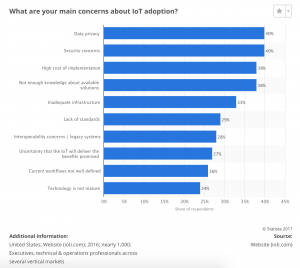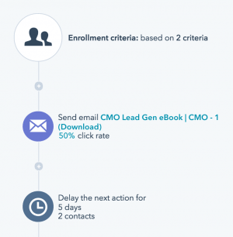
According to VisionMobile’s IoT Megatrends 2016 report, 4.5 million developers are working on IoT applications.
- "Additionally, IDC estimates the IoT solutions market value will reach $7.1 trillion in 2020."
Marketers in technology marketing face an exciting opportunity. We can help create awareness and aid in the adoption of connected devices coming to market. The marketing method most suited to IoT is undoubtedly the inbound marketing methodology.
However, when marketing IoT products/services to prospects, marketers face very specific challenges.
Here are five things to consider when developing your IoT marketing strategy.
According to a survey by FC Business Intelligence, “understanding the technology” is the top challenge to adopting IoT solutions for 55% of insurance industry respondents.
While technical buyers may have a deeper understanding of IoT products and services, oftentimes, non-technical executives will also need to be a part of the decision-making process.
Therefore, it’s up to marketers to create engaging and educational multimedia-rich content that speaks to both audiences. Simultaneously, they must help less educated buyers to understand the IoT implementation process.
Cisco estimates 50 billion devices will be connected by 2020. But 33% of survey respondents say that security slows their IoT adoption, according to FC Business Intelligence.
 Along with the connection of that massive number of devices comes a considerable amount of fear and hesitation.
Along with the connection of that massive number of devices comes a considerable amount of fear and hesitation.
Buyers and consumers fear that their privacy will be violated and that their connected devices will be vulnerable to hackers. Unfortunately, fear can be a very strong deterrent.
To combat fear, marketers must work toward establishing trust. IoT buyers must be nurtured, reassured, and educated about the risks involved, as well as the security protocols in place for the IoT product/service being considered. Content will play a huge role. IoT marketers should produce case studies, infographics, and white papers detailing security concerns transparently and showing solutions in a way that both technical and non-technical leads will understand.
The sales cycle has grown 22% longer across B2B industries, according to SiriusDecisions.
 However, thanks to the learning curve, IoT security concerns and other considerations, an even longer sales cycle is likely on the horizon. IoT marketers must drive the sales process by providing buyers with more touch points and content that offers practical solutions for the unique challenges that IoT buyers face.
However, thanks to the learning curve, IoT security concerns and other considerations, an even longer sales cycle is likely on the horizon. IoT marketers must drive the sales process by providing buyers with more touch points and content that offers practical solutions for the unique challenges that IoT buyers face.
Automated nurture workflows are one high-tech way to pave a clear educational path. A set-it-and-forget-it HubSpot workflow, for example, can send relevant touch points with appropriate time delays.
Demand generation is vital to any industry but is especially required for an emerging industry such as IoT.
While on average, it can take 7-13 touches to generate a viable sales lead (Online Marketing Institute), IoT buyers are likely to require more.
As with any disruptive technology, buyers aren’t initially aware of their need for a specific product or service. Therefore, it’s important to share the benefits of IoT early on through highly targeted content, ads, and other offers.
An IBM and Econsultancy survey finds that a siloed organizational structure is preventing 59% of marketers from understanding the full buyer’s journey.
Yet, When sales and marketing teams work together, companies see 36% higher customer retention and 38% higher sales win rates, according to the TAS Group.
Marketing and sales must join forces, creating cohesive IoT content that educates, nurtures, and builds trust among target audiences.
The stats speak for themselves. The Internet of Things is a huge industry that’s only getting bigger and represents an enormous IoT marketing opportunity with the right skill set. Those that can tell a new story by educating buyers while quelling their fears and providing a consistent message at every touch point will certainly create demand for this new class of products and services.
Moreover, marketers that partner with sales, tearing down the information silos that stifle so many organizations, are much more likely to succeed in this hyperconnected world.
If you need guidance, consider partnering with a digital strategy agency for long-term growth.
Sources
VisionMobile, https://www.visionmobile.com/reports/iot-megatrends-2016
IDC via ZDnet, https://www.zdnet.com/article/internet-of-things-market-to-hit-7-1-trillion-by-2020-idc/
FC Business Intelligence https://www.statista.com/statistics/486156/challenges-of-internet-of-things-adoption-insurance-companies-usa/
Cisco, https://www.cisco.com/c/dam/en_us/about/ac79/docs/innov/IoT_IBSG_0411FINAL.pdf
SiriusDecisions via Protocol 80, Inc. https://www.protocol80.com/blog/21-lead-nurturing-statistics-that-show-the-power-of-marketing-automation-and-workflows
The TAS Group via HubSpot https://blog.hubspot.com/sales/stats-that-prove-the-power-of-smarketing-slideshare
IBM, Econsultancy, https://www.statista.com/statistics/683411/barries-customer-journey-usa/
Online Marketing Institute, https://www.onlinemarketinginstitute.org/blog/2013/10/why-it-takes-7-to-13-touches-to-deliver-a-qualified-sales-lead-part1/
by Jonathan Franchell, CEO of Ironpaper - For more tips and hacks: Need to remove a new line after h1 tags? Both web designers and SEO practitioners need to employ headline tags: H1, H2, H3 in several ways to improve web page structure and tag...

The marketing industry is transforming significantly due to generative AI and increasing market complexity. Gartner's prediction of a 25% decline in traditional search traffic suggests that the era of search engines is dying. AI tools, particularly...

The Crowded Arena of the IT Marketplace Updated December 2024 The Information Technology (IT) landscape is experiencing rapid growth and intensifying competition. IT spending is projected to reach nearly 5.1 trillion U.S. dollars in 2024, a...

Updated December, 2024 The field of digital marketing is evolving rapidly in response to new technology and changing buyer expectations. To help career-minded marketers, we’ve rounded up the top 10 skills needed to succeed in the field. These are...
